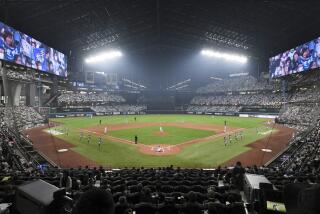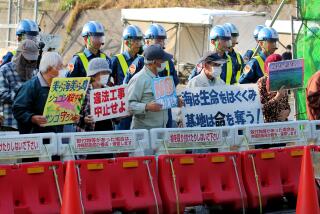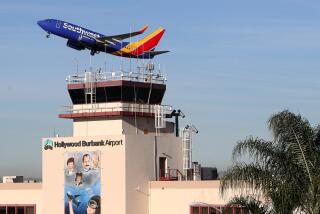An Unlikely Field of Battle
- Share via
NARITA, Japan — Katsushige Aikawa was a 21-year-old farmer when he joined neighbors and their radical leftist supporters one long-ago morning to battle riot police come to seize land here for a new Tokyo airport.
As rocks and flaming bottles of gasoline rained onto bulldozers and water trucks, Aikawa was among a group of about 700 protesters armed with bamboo poles who overwhelmed an isolated contingent of 260 police. Three officers were beaten to death, and Aikawa was one of dozens arrested.
Despite years of bitter resistance, the government eventually took enough land to build Narita Airport--but with just one runway, not the three originally planned. The facility opened in 1978, two months after a last-ditch protest in which masked and helmeted leftists took over the almost-finished control tower and smashed its equipment.
The uprising over Narita was a landmark event in Japan’s post-World War II history, shaping government and public attitudes and inspiring dozens of other grass-roots movements throughout the country. It has made the traditionally passive Japanese more assertive of their rights.
Nor do they need to look far for renewal: The Narita airport campaign has taken on a life of its own. In what is surely one of the longest-running protests of modern times, a die-hard band of farmers still grows vegetables in the path of a proposed second runway and refuses to move.
“It was a simple anti-airport resistance movement at the beginning,” said Hideo Yanagawa, 50, co-owner of a vegetable-packing plant that stands on the proposed runway site.
“But in the past 30 years I have learned so much. For us, the airport is something very industrial and too modern. It resulted from this culture of mass production, mass consumption and mass exhaustion.”
The protests never fully stopped, and as the need for a second runway has escalated, the government’s expansion efforts have grown. In 1983, a timed firebomb exploded at an airport workers’ dormitory, killing two. Nonlethal incidents have continued, as Japan was reminded just last month when a bomb blew the roof off the garage of a local official working on land acquisition.
While there is almost no public support for those radicals who still use bombs or homemade missiles to oppose the airport, many Japanese remain sympathetic to the holdout farmers’ goals of a more environmentally conscious and citizen-ruled Japan.
The airport opponents see Japan as threatened by the relentless march of dehumanizing technology. And they see themselves as heroes in what is not just a battle to save a rural community from a brutally insensitive government, but an ongoing struggle for the very soul of Japan.
Others view them as vaguely noble but quixotic in their hopes of doing anything more than blocking an airport runway.
“I think it’s about time they should give up,” said Asako Ichigun, 27, a Tokyo housewife. “It’s impossible to change this society now. It’s too late.”
Today, former protester Aikawa, 47, is mayor of Shibayama, a town next to the airport. Like many former ‘60s radicals here and elsewhere whose views have seasoned with age, he tries to reconcile the initial protest with his more traditional outlook in the ‘90s.
*
Aikawa still says the anti-airport struggle--which ultimately cost the lives of four policemen and one protester--was right in its time. But he now favors completion of a second runway that would dramatically boost the capacity of the still heavily guarded facility, helping it to better fulfill its role as the major gateway to Japan.
“They forced the airport on the community because we didn’t have a mature democracy at that time,” Aikawa said. But now that the airport is a reality, he said, local residents should benefit from it rather than keep on fighting.
Meanwhile, behind a barbed-wire perimeter and amid high-profile police security, daily departures and arrivals at Narita Airport come with assembly-line regularity: As one jet lands, two others descend in line behind it. Others on the tarmac await their moment to take off.
The tight scheduling enables Narita, despite its single runway, to handle about 25 million passengers a year. It ranks sixth in the world in international travelers. Tokyo’s older airport, Haneda, handles domestic flights. Some experts say Narita and Haneda could both be enlarged and still be far from adequate to properly serve the Tokyo region.
Landing slots are so scarce at Narita that 40 foreign airlines are waiting for permission to fly in. Japanese carriers cannot expand services. No second runway means no price-busting competition. The result: Air fares out of Tokyo are among the highest in the world. At the busiest times, travelers endure long lines and maddening waits in jammed terminal buildings to check in for their flights and pass through customs.
Narita is the world’s No. 1 airport in value of international air cargo, yet does not come close to meeting the demand for shipments of Japanese electronics and other high-technology exports.
A second runway and additional terminal space would go far to ease these pressures.
The Japanese government insists it will complete the long-planned second runway by March 31, 2001. But it has also apologized for its past methods and promised not to use forced expropriation to acquire the rest of the necessary land. Some anti-airport landowners, with feelings similar to Aikawa’s, have responded to the government’s softer approach by agreeing to sell.
At least in its public face, the government is full of rosy confidence that these remaining landowners will give up their fight, and that the second runway will soon be built. “I believe it will be ready” on time, Narita Airport Authority spokesman Yoshio Kobayashi declared in a recent interview.
Government authorities, however, have relatively little contact with the most embittered opponents of airport expansion. Based on what these anti-airport activists say, the time schedule for Narita expansion seems wildly unrealistic. The battle of Narita is far from over--at least if the government adheres to its promise not to seize the land by force.
The single most critical piece of land still needed for airport expansion is the home and fields of the Shimamura family, in the middle of the runway path. And the Shimamuras say they remain unyielding in their opposition to airport expansion.
Ironically, it was the government that resettled Hatsue Shimamura, 77, and her husband here after World War II, when Japan lay in ruins and food production was a top priority.
“This was mostly a bamboo forest, with some huge pine trees,” she recalled. “We didn’t have technology. We used hand tools. I had to cut the roots of the pine trees, dig them out and flip them over to dry and burn them. I did that for 10 years.”
Her son Shoji Shimamura, 51, said he will fight the airport for as long as he can farm. His wife, Fujiko, 49, is a former student radical who joined the anti-airport fight and then put down roots here. They say that their two sons, ages 18 and 22, also plan to be farmers. That means there is at least the potential for the struggle to be passed on to fresh generations.
“I can say it’s impossible to build [the second runway] by 2001 because we have no intention of selling or leaving this place,” Shoji Shimamura said.
“The authorities are saying they want to construct the airport in a democratic way. If they go along that line, they can’t really force us to leave. I have the freedom to sell this land or not to sell it. As long as I have this attitude, the construction of the second runway is impossible,” he said.
The Shimamuras say they don’t even know--or care--how much the government would be willing to pay them for their home and land.
“They sent us mail, and probably it says how much our land value is, but we refused to take it and sent it back,” Fujiko Shimamura said. “We’ve never negotiated conditions.”
To build the second runway, the government not only must acquire the Shimamuras’ property and the vegetable packing workshop owned by Yanagawa and other anti-airport farmers, but also a scallion-pickling factory owned by two aging but still-committed leftists and scattered tiny plots of land that activists bought from farmers many years ago for the specific purpose of blocking airport expansion.
*
The scallion-pickling factory, just a minute’s walk from the Shimamura home, is owned by Kiyonori Hirano, 52, a former Maoist student radical, and his business partner Tadashi Sayama, 55, who said the label “Maoist” still suits him just fine.
Deeply committed anti-airport activists for more than 30 years, the two friendly and soft-spoken men say they will carry on for as long as any farmers keep up the fight and the urban supporters who buy their products want them to stay.
By pledging to solve the dispute over airport expansion through peaceful discussion, the government has lost the option of using force to drive out the remaining resisters, Sayama added.
“The government has made a promise with all the Japanese public watching,” he noted. “They can’t go back to doing things the way they used to.”
Etsuko Kawase and Chiaki Kitada of The Times’ Tokyo bureau contributed to this report.
More to Read
Sign up for Essential California
The most important California stories and recommendations in your inbox every morning.
You may occasionally receive promotional content from the Los Angeles Times.










